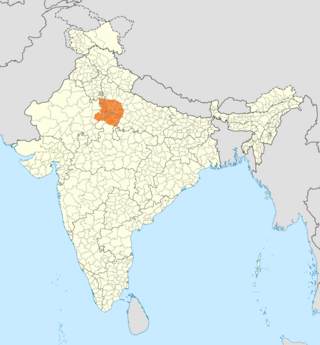Braj Bhasha
| Braj | |
|---|---|
| Brij Bhasha | |
| ब्रजभाषा | |
| Native to | India |
| Region | Braj |
| Ethnicity | Brajwasi |
Native speakers | 1,600,000 (2011 census)[1] Census results conflate some speakers with Hindi.[2] |
| Devanagari | |
| Language codes | |
| ISO 639-2 | bra |
| ISO 639-3 | bra |
| Glottolog | braj1242 |
 Braj-speaking region | |
Braj[a] is a language within the Indo-Aryan language family spoken in the Braj region in Western Uttar Pradesh centered on Mathura. Along with Awadhi, it was one of the two predominant literary languages of North-Central India before gradually merging and contributing to the development of standardized Hindi in the 19th century. It is spoken today in its unique form in many districts of west Uttar Pradesh, often referred to as 'Central Braj Bhasha'.
The language was historically used for Vaishnavite poetry dedicated to Krishna, whose life was associated with sites in the Braj region. There were also early prose works in terms of the hagiographical vārtā literature of the Vallabha sect.[3]
Braj is considered by scholars to be a more conservative example of the Central Indo-Aryan languages compared to the Hindustani language, which has been influenced by Panjabi and intermediate dialects.[4]
Geographical distribution
[edit]Braj Bhasha is spoken in the nebulous Braj region centred on Mathura & Agra in Uttar Pradesh and Bharatpur, Karauli, Gangapur & Dholpur in Rajasthan. It is the predominant language in the central stretch of the Ganges-Yamuna Doab in the following districts:
- Hathras
- Mathura
- Agra
- Aligarh
- Firozabad
- Auraiya
- Etah
- Mainpuri
- Etawah
- Farrukhabad
- Kasganj
- Badaun
- Palwal
- Karauli
- Gangapur
- Bharatpur
- Deeg
It is also spoken in the western areas of Uttar Pradesh, mainly in Mathura district and southern areas of Palwal district
In Madhya Pradesh it is spoken in the districts of :
It is spoken in several villages of Mathura, specially in Vrindavan, Madhuvan, Kaman, Kosi Kalan, Chhata, Baldeo, and all other villages belongs to Braj Area with Bajna, Surir, Bhidauni,
Literature
[edit]Most Braj literature is of a mystical nature, related to the spiritual union of people with God, because almost all of the Braj Bhasha poets were considered God-realised saints and their words are thus considered as directly emanating from a divine source. Much of the traditional Northern Indian literature shares this trait. All traditional Punjabi literature is similarly written by saints and is of a metaphysical and philosophical nature.
Another peculiar feature of Northern Indian literature is that the literature is mostly written from a female point of view, even by male poets. This is because the saints were in a state of transcendental, spiritual love, where they were metaphorically women reuniting with their beloved. (In its inversion of the conventional genders of worshipper and worshippee, Maulana Da’ud's Chandayan departs from this tradition.)
Important works in Braj Bhasha are:
- Pushtimargiya kiratan of ashtachhap.
- Yugala Shataka by Swami Sri Sribhatta Devacarya; known as the first 'Vani' book in Vraja Bhasha composed in the 14th Century AD as a part of Nimbarka Sampradaya tradition of Radha Krishna worship.
- Vinaya Patrika by Tulsidas
- Sur Sagar by Surdas[6]
- Buddha Charit by Acharya Ram Chandra Shukla
- Sufi poetry by Amir Khusro
- Eulogies by Kavi Bhushan
- Nayikabhed, Nakhshikh and satasattak by Chhatrapati Sambhaji Maharaj.[7]
- Vrind Satsai by Vrind (1643 - 1723), court poet of ruler of Kishangarh[8]
See also
[edit]Notes
[edit]- ^ commonly called Braj Bhasha, also known as Vraj Bhasha or Brij Bhasha or Braj Boli
References
[edit]- ^ "Statement 1: Abstract of speakers' strength of languages and mother tongues - 2011". www.censusindia.gov.in. Office of the Registrar General & Census Commissioner, India. Retrieved 7 July 2018.
- ^ "Census of India: Abstract of speakers' strength of languages and mother tongues –2001". censusindia.gov.in. Retrieved 16 July 2015.
- ^ Masica, Colin P. (1991). The Indo-Aryan Languages. Cambridge University Press. pp. 53, 57, 62.
- ^ Masica 1991, p. 197-198.
- ^ Frawley, William (May 2003). International Encyclopedia of Linguistics. ISBN 9780195139778. Retrieved 16 July 2015.
- ^ "Google Notebook". google.com. Retrieved 16 July 2015.
- ^ Atre, Shubhangana (2019). History. Maharashtra: Maharashtra state textbook bureau.
- ^ Sujit Mukherjee (1998). A Dictionary of Indian Literature: Beginnings-1850. Orient Blackswan. pp. 425–. ISBN 978-81-250-1453-9.
Further reading
[edit]- Snell, Rupert. 1991. The Hindi Classical Tradition: A Braj Bhāṣā Reader ISBN 0728601753
- Snell, Rupert. 2016. Braj in Brief: An introduction to literary Braj Bhāṣā
